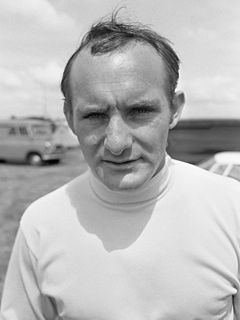
Stanley Michael Bailey Hailwood, was a British Grand Prix motorcycle road racer. He is regarded by many as one of the greatest racers of all time.

Matchless is one of the oldest marques of British motorcycles, manufactured in Plumstead, London, between 1899 and 1966. A wide range of models was produced under the Matchless name, ranging from small two-strokes to 750 cc four-stroke twins. Matchless had a long history of racing success; a Matchless ridden by Charlie Collier won the first single-cylinder race in the first Isle of Man TT in 1907.

The Honda CB450 is a standard motorcycle made by Honda from 1965 to 1974 with a 444 cc (27.1 cu in) 180° straight-twin, dohc engine. Producing 45 bhp, it was Honda's first "big" motorcycle.

Phillip William Read, is an English former professional motorcycle racer. He competed in Grand Prix motorcycle racing from 1961 to 1976. Read is notable for being the first competitor to win world championships in the 125 cc, 250 cc and 500 cc classes. Although he was often overshadowed by his contemporary, Mike Hailwood, he won seven FIM Grand Prix road racing world championships. In 2013, Read was named an FIM Legend for his motorcycling achievements.

The Triumph Trident and BSA Rocket 3 was a technically advanced, high-performance roadster motorcycle made by Triumph Engineering and BSA from 1968 to 1975, and sold under both the Triumph and BSA marques. Alongside the Honda CB750, and later the Kawasaki triples, it brought a new level of sophistication to street motorcycles, marking the beginning of the superbike era. The Honda CB750 overshadowed the Trident to be remembered as the 'first superbike', in spite of the Triumph Trident actually debuting before the Honda by a few weeks.

Geoff Monty was an English professional motorcycle racer, constructor, rider-sponsor and retail dealer, initially based in Kingston on Thames and later – under the name Monty and Ward – Twickenham areas, near London, with a move to Edenbridge, Kent by 1968.

The BSA Gold Star is a motorcycle made by BSA from 1938 to 1963. They were 350 cc and 500 cc single-cylinder four-stroke production motorcycles known for being among the fastest bikes of the 1950s. Being hand built and with many optional performance modifications available, each motorcycle came from the factory with documented dynamometer test results, allowing the new owner to see the horsepower produced.
Greeves Motorcycles was a British motorcycle manufacturer founded by Bert Greeves which produced a range of road machines, and later competition mounts for observed trials, scrambles and road racing. The original company produced motorcycles from 1952, funded by a contract with the Ministry of Pensions for their Invacar, a three-wheeler for disabled drivers.

The BSA Rocket Gold Star (RGS) was a 646 cc (39.4 cu in) air-cooled parallel twin motorcycle produced by Birmingham Small Arms Company (BSA) at Small Heath, Birmingham. Launched in February 1962, it was one of the final range of A10 twins, using a tuned A10 Super Rocket engine in the double-downtube Gold Star frame.
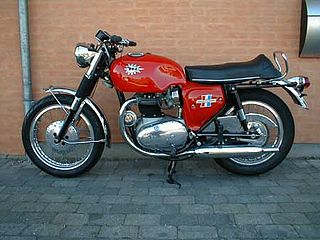
The BSA Spitfire was a high-performance BSA motorcycle made from 1966 to 1968 with model designations of MkII, MkIII and MkIV. Announced at the Brighton motorcycle show held during September 1965, it was based on the earlier BSA Lightning with a power-upgrade achieved by higher compression-ratio 10.5:1 pistons and two large-bore Amal GP carburetors with velocity stacks it was one of the first BSAs to have 12-volt electrics. At introduction in 1966, it was the fastest standard BSA ever produced and the fastest standard motorcycle tested by Motor Cycle with a best run at 123 mph and average of 119.2 mph The Spitfire was used for travelling Marshalls' course duties at the 1967 Isle of Man TT races.
The Thruxton 500 was a motorcycle endurance race for production based road machines, covering 500 miles and ridden by a team of two riders per machine. The first event was a 9-hour race which took place in 1955, organized by the Southampton and District Motorcycle Club (SDMCC) at the Thruxton Circuit near Andover in Hampshire. Two more 9-hour races followed in 1956 and 1957.

The Velocette Venom was a 499 cc single-cylinder four-stroke British motorcycle made by Velocette at Hall Green in Birmingham. A total of 5,721 machines were produced between 1955 and 1970.

The featherbed frame was a motorcycle frame developed by the British Norton motorcycle company to improve the performance of their racing motorcycles around the twisting and demanding Isle of Man TT course in 1950. It was considered revolutionary at the time, and the best handling frame that a racer could have. Later adopted for Norton production motorcycles, it was also widely used by builders of custom hybrids such as the Triton, becoming legendary and remaining influential to this day.

The BSA Lightning was a British BSA 650 cc-class motorcycle made in Birmingham between 1965 and 1972.

The BSA A7 was a 500cc motorcycle model range made by Birmingham Small Arms Company (BSA) at their factory in Armoury Road, Small Heath, Birmingham. The range was launched in 1946 using a 495 cc (30.2 cu in) long stroke engine. An improved 497 cc (30.3 cu in) version based on the BSA A10 engine was launched in 1950. The various A7 models continued in production with minor modifications until 1961/2 when they were superseded by the unit-construction A50 model.
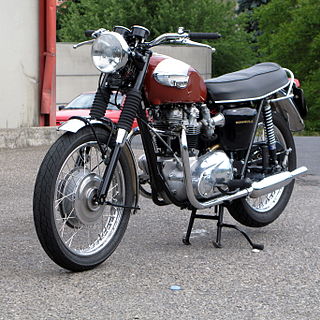
The Triumph Bonneville T120 is a motorcycle originally made by Triumph Engineering from 1959 to 1975. It was the first model of the Bonneville series, which was continued by Triumph Motorcycles Ltd. The T120 was discontinued in favour of the larger 750 cc T140 in the early 1970s.
Colin Jordan Seeley was an English motorcycle retailer who later became a successful motorcycle sidecar racer, motorcycle designer, constructor and retailer of accessories. In 1992 he was involved in running the Norton Rotary race team.
BSA motorcycles were made by the Birmingham Small Arms Company Limited (BSA), which was a major British industrial combine, a group of businesses manufacturing military and sporting firearms; bicycles; motorcycles; cars; buses and bodies; steel; iron castings; hand, power, and machine tools; coal cleaning and handling plants; sintered metals; and hard chrome process.
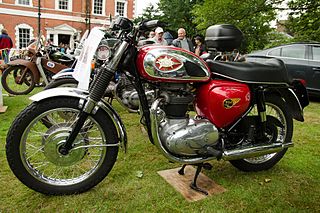
The BSA unit twins were a range of unit construction twin-cylinder motorcycles made by the Birmingham Small Arms Company (BSA) and aimed at the US market. A range of 500 cc (31 cu in), 650 cc (40 cu in) and 750 cc (46 cu in) twins were produced between 1962 and 1972, but they were really developments of the older pre-unit A7/A10 model range with less weight. The engines had a reputation for vibration, but acceleration was good for the time, to a top speed of 100 miles per hour (160 km/h).
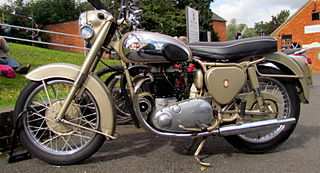
The BSA A10 series was a range of 646 cc (39.4 cu in) air-cooled parallel twin motorcycles designed by Bert Hopwood and produced by Birmingham Small Arms Company at Small Heath, Birmingham from 1950 to 1963. The series was succeeded by the A65 unit construction models.

















